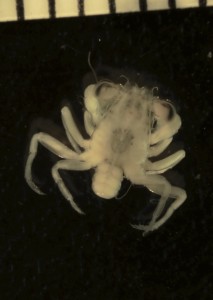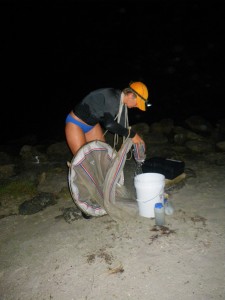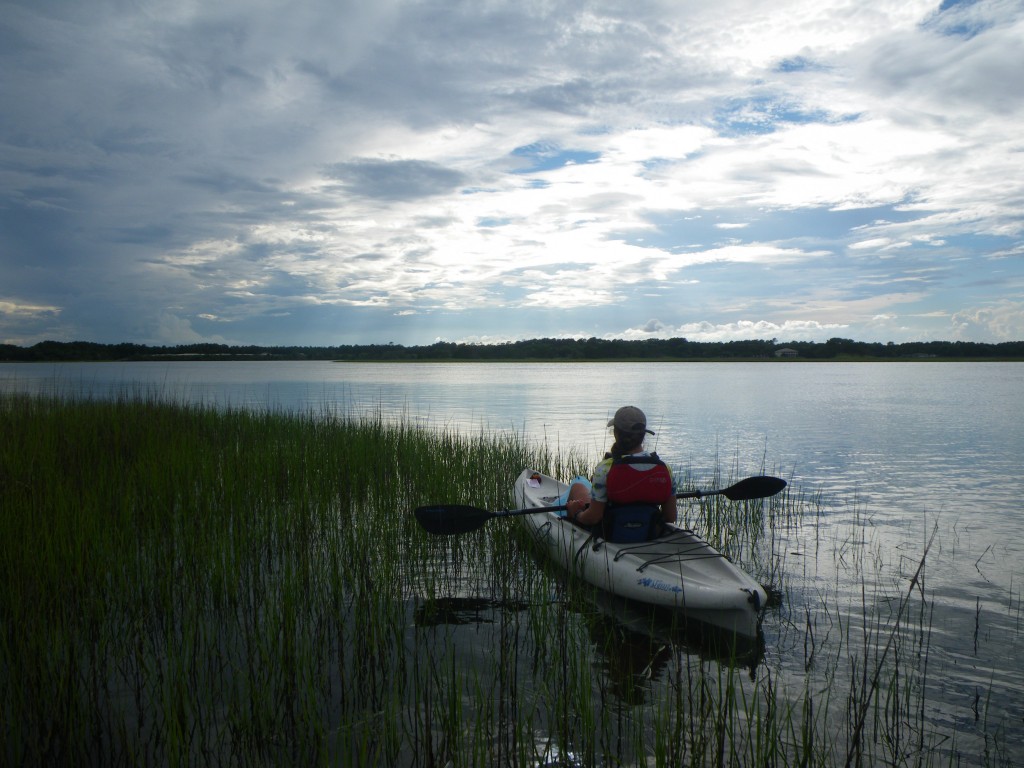by Cora Johnston
When studying major ecological changes, like the movement of entire species or ecosystems, we often have to sample across large geographic areas. This means lots of road trips!
Starting nearly two months ago, I began my own road trips along the coast to survey the larval crabs that are washing ashore in swarms. Crabs typically recruit (leave the open ocean as larvae to join adult populations in coastal habitats) in a few brief but frenzied weeks in late spring and early fall. Therefore, I’ve been busy hopping between sites to gather as much data as I can while the crabs are abundant. Unfortunately, this means that my schedule, like the crabs’, depends on moonlight and tides. I’ll wake up around midnight, drive until the wee hours of the morning, and then sample the incoming tides by moonlight until wrapping up and moving to my next site as the sun rises. I then load up a kayak and spend the day paddling around collecting larger crabs (though still far too tiny to eat) from deep in each habitat to compare to the larvae I find riding the currents at night.I head off on these adventures wielding stacks of audiobooks, a hefty thermos and lots of pre-labeled jars and data sheets that ease the demands on a weary mind. I munch trail mix to battle the exhaustion and swim to soothe the bug bites. After a few weeks on this schedule, even I find it hard to believe that I will get up at midnight the very next week to start all over again. Luckily, what keeps me coming back is what got me out of bed to do these studies in the first place.
As I start my sampling in the deep darkness of early morning, I stand all alone on a dock and watch a starry sky flicker along the water’s surface as drifting planktonic larvae phosphoresce, bumping along into my net. I learn to recognize dolphins strictly by the sound of bodies in water. I listen to pelicans clamber nearby. While enjoying a Thoreauvian solitude, I am collecting information about biological processes that most folks sleep right through.

Post-larval crabs, known as megalopae, actively select and settle into nursery habits such as mangroves and marshes. The black marks at the top are millimeter marks on a ruler. (Cora Johnston)
From previous studies, we know that the nursery phase—when aquatic organisms seek wetlands for safe harbor—particularly influences the population’s future. Crabs release millions of eggs each year, but the breeding population eventually contains perhaps an order of magnitude fewer adult crabs. The vast majority of that decline comes from larvae that succumb to predation or starvation. Their best bet is to find a good nursery habitat—one that provides both food and refuge.
I am studying larval settlement into coastal habitats to examine whether mangroves and marshes differ in nursery habitat quality, and whether crabs can distinguish between them. Based on previous studies, I expect that even these tiny larvae can tell grass blades from woody roots. Thus, where mangroves expand, crab communities may change in response. The question now is, will we detect different species, or will the demographics of current inhabitants simply change as the quality of habitat changes around them?
Learn how mangroves and marshes are changing >>

Ecologists use plankton nets to collect speck-sized larval crabs as they ride the tide into coastal ecosystems. (Emily Dark)
Through the misery of exhaustion, I notice a stingray zip along the sand beneath me. A light breeze swirls among the mangroves that are alive with the “pops” of snapping shrimp. A sea turtle that could perch on a dinner plate surfaces within my reach. I pull in collector after collector crawling with dozens of varieties of crabs that are still small enough to scuttle around on a pencil eraser. Paddling back to a literal truckload of samples—soon to be new and exciting data about species that we depend on ecologically and economically—the sun dips below the horizon, yellow-crowned night herons arrive, and the ripple just ahead of me turns out to be a manatee lazing about in the warmth of the shallows. I’m euphoric, rather than miserable, as these soothing natural encounters mix with my building excitement about what each new sample will reveal.
The next day I am back at it again, this time at the lab sorting all those tiny crabs I just collected. I encounter the crowd of regulars – crabs I see in nearly every sample, likely because they are broadly-adapted generalists. But I also stumble across rare and exciting species: ones that appear only in a specific habitat; ones that unexpectedly pop up where we least expect them (stay tuned for future posts on this topic).
In the coming months, I will use these collections to look deeper into patterns of species distributions. Decoding their distributions will help us more clearly depict what our coastal ecological communities may look like in the coming decades. In the end, much of my power of inference will come from comparisons of far-flung sites and conditions, made possible by long road trips and late nights.
More stories from the mangroves >>
Cora Johnston is a student at the University of Maryland and a Link Fellow with the Smithsonian Marine Station in Ft. Pierce, Fla.
This material is based upon work supported by the National Science Foundation under Grant Number 1065098. Any opinions, findings, and conclusions or recommendations expressed in this material are those of the author(s) and do not necessarily reflect the views of the National Science Foundation.



Great article! That’s a fascinating topic studying habitual changes in marshes vs. mangroves. Where in the Ft. Pierce mangroves are you placing these plankton nets?
I deploy my plankton tows from docks in most inlets from Stuart to Jacksonville. I collect larvae before they arrive in the mangrove habitats; collecting in inlets helps me gather the most concentrated sample of crabs entering each waterway. In Ft Pierce, I collect by the St Lucie Aquarium, just east of the south bridge.